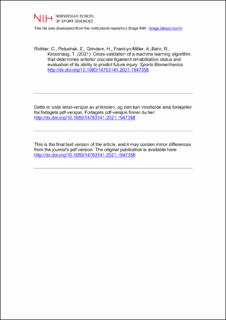| dc.contributor.author | Richter, Chris | |
| dc.contributor.author | Petushek, Erich | |
| dc.contributor.author | Grindem, Hege | |
| dc.contributor.author | Franklyn-Miller, Andrew | |
| dc.contributor.author | Bahr, Roald | |
| dc.contributor.author | Krosshaug, Tron | |
| dc.date.accessioned | 2022-07-26T10:09:19Z | |
| dc.date.available | 2022-07-26T10:09:19Z | |
| dc.date.created | 2021-10-06T13:57:45Z | |
| dc.date.issued | 2021 | |
| dc.identifier.citation | Sports Biomechanics. 2021 | en_US |
| dc.identifier.issn | 1476-3141 | |
| dc.identifier.uri | https://hdl.handle.net/11250/3008546 | |
| dc.description | Dette er siste tekst-versjon av artikkelen, og den kan inneholde små forskjeller fra forlagets pdf-versjon. Forlagets pdf-versjon finner du på tandfonline.com / This is the final text version of the article, and it may contain minor differences from the journal's pdf version. The original publication is available at tandfonline.com | en_US |
| dc.description.abstract | Classification algorithms determine the similarity of an observation to defined classes, e.g., injured or healthy athletes, and can highlight treatment targets or assess progress of a treatment. The primary aim was to cross-validate a previously developed classification algorithm using a different sample, while a secondary aim was to examine its ability to predict future ACL injuries. The examined outcome measure was ‘healthy-limb’ class membership probability, which was compared between a cohort of athletes without previous or future (No Injury) previous (PACL) and future ACL injury (FACL). The No Injury group had significantly higher probabilities than the PACL (p < 0.001; medium effect) and FACL group (p ≤ 0.045; small effect). The ability to predict group membership was poor for the PACL (area under curve [AUC]; 0.61<AUC<0.62) and FACL group (0.57<AUC<0.59). The ACL injury incidence proportion was highest in athletes with probabilities below 0.20 (9.4%; +2.7% to baseline), while athletes with probabilities above 0.80 had an incidence proportion of 4.1% (−2.6%). While findings that a low probability might represent an increase in injury risk on a group level, it is not sensitive enough for injury screening to predict a future injury on the individual level. | en_US |
| dc.language.iso | eng | en_US |
| dc.subject | classification algorithms | en_US |
| dc.subject | injury prediction | en_US |
| dc.subject | vertical drop jump | en_US |
| dc.title | Cross-validation of a machine learning algorithm that determines anterior cruciate ligament rehabilitation status and evaluation of its ability to predict future injury | en_US |
| dc.title.alternative | Cross-validation of a machine learning algorithm that determines anterior cruciate ligament rehabilitation status and evaluation of its ability to predict future injury | en_US |
| dc.type | Peer reviewed | en_US |
| dc.type | Journal article | en_US |
| dc.description.version | acceptedVersion | en_US |
| dc.source.pagenumber | 11 | en_US |
| dc.source.journal | Sports Biomechanics | en_US |
| dc.identifier.doi | 10.1080/14763141.2021.1947358 | |
| dc.identifier.cristin | 1943814 | |
| dc.description.localcode | Institutt for idrettsmedisinske fag / Department of Sports Medicine | en_US |
| cristin.ispublished | true | |
| cristin.fulltext | postprint | |
| cristin.qualitycode | 1 | |
